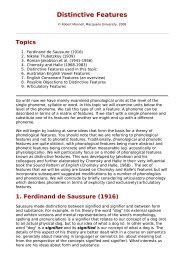Festival Speech Synthesis System: - Speech Resource Pages
Festival Speech Synthesis System: - Speech Resource Pages
Festival Speech Synthesis System: - Speech Resource Pages
You also want an ePaper? Increase the reach of your titles
YUMPU automatically turns print PDFs into web optimized ePapers that Google loves.
(debug_output t)<br />
before compilation. This will print out each entry as it is read in which should help to narrow down where the error<br />
is.<br />
[ < ] [ > ] [ > ] [Top] [Contents] [Index] [ ? ]<br />
13.3 Lookup process<br />
When looking up a word, either through the C++ interface, or Lisp interface, a word is identified by its headword and<br />
part of speech. If no part of speech is specified, nil is assumed which matches any part of speech tag.<br />
The lexicon look up process first checks the addenda, if there is a full match (head word plus part of speech) it is<br />
returned. If there is an addenda entry whose head word matches and whose part of speech is nil that entry is<br />
returned.<br />
If no match is found in the addenda, the compiled lexicon, if present, is checked. Again a match is when both head<br />
word and part of speech tag match, or either the word being searched for has a part of speech nil or an entry has its<br />
tag as nil. Unlike the addenda, if no full head word and part of speech tag match is found, the first word in the<br />
lexicon whose head word matches is returned. The rationale is that the letter to sound rules (the next defence) are<br />
unlikely to be better than an given alternate pronunciation for a the word but different part of speech. Even more so<br />
given that as there is an entry with the head word but a different part of speech this word may have an unusual<br />
pronunciation that the letter to sound rules will have no chance in producing.<br />
Finally if the word is not found in the compiled lexicon it is passed to whatever method is defined for unknown<br />
words. This is most likely a letter to sound module. See section 13.4 Letter to sound rules.<br />
Optional pre- and post-lookup hooks can be specified for a lexicon. As a single (or list of) Lisp functions. The prehooks<br />
will be called with two arguments (word and features) and should return a pair (word and features). The posthooks<br />
will be given a lexical entry and should return a lexical entry. The pre- and post-hooks do nothing by default.<br />
Compiled lexicons may be created from lists of lexical entries. A compiled lexicon is much more efficient for look up<br />
than the addenda. Compiled lexicons use a binary search method while the addenda is searched linearly. Also it<br />
would take a prohibitively long time to load in a typical full lexicon as an addenda. If you have more than a few<br />
hundred entries in your addenda you should seriously consider adding them to your compiled lexicon.<br />
Because many publicly available lexicons do not have syllable markings for entries the compilation method supports<br />
automatic syllabification. Thus for lexicon entries for compilation, two forms for the pronunciation field are<br />
supported: the standard full syllabified and stressed form and a simpler linear form found in at least the BEEP and<br />
CMU lexicons. If the pronunciation field is a flat atomic list it is assumed syllabification is required.<br />
Syllabification is done by finding the minimum sonorant position between vowels. It is not guaranteed to be accurate<br />
but does give a solution that is sufficient for many purposes. A little work would probably improve this significantly.<br />
Of course syllabification requires the entry's phones to be in the current phone set. The sonorant values are calculated<br />
from the vc, ctype, and cvox features for the current phoneset. See<br />
`src/arch/festival/Phone.cc:ph_sonority()' for actual definition.<br />
Additionally in this flat structure vowels (atoms starting with a, e, i, o or u) may have 1 2 or 0 appended marking<br />
stress. This is again following the form found in the BEEP and CMU lexicons.<br />
Some example entries in the flat form (taken from BEEP) are<br />
("table" nil (t ei1 b l))<br />
("suspicious" nil (s @ s p i1 sh @ s))
















